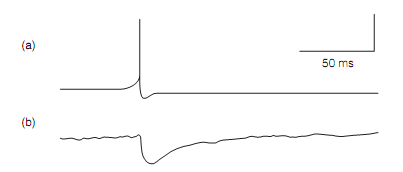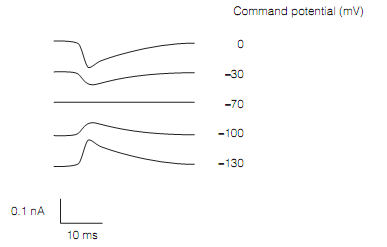Inhibitory postsynaptic potentials
The Activation of ionotropic receptors which conduct chloride ions channels decreases the probability of neuron firing. The most significant fast inhibitory transmitters are γ- aminobutyrate (GABA) and glycine. The result of GABA can be seen in the experiment illustrated in figure which is shown below. The Pyramidal cells in cerebral cortex have many GABAergic axosomatic synapses impinging on them from the interneurons. Activating the interneuron generates a modest hyperpolarization, that is the inhibitory postsynaptic potential (ipsp), as it carries the membrane potential away from the threshold for firing the action potentials. The Inhibitory postsynaptic potentials have very alike properties to epsps.

Figure: Inhibitory postsynaptic potential in a pyramidal cell formed by GABA release from an inhibitory neuron: (a) presynaptic action potential in basket cell, vertical scale bar 25 mV; (b) postsynaptic potential in a pyramidal cell, vertical scale bar of 0.5 mV.
The figure below shows what happens to the ipsp caused by GABA at distinct pyramidal cell membrane potentials. At -70 mV the GABA creates no change in potential. This is the equilibrium potential for chloride, ECl. Here there is no net flow of Cl- through the activated GABA receptor. There are two other situations to consider. At First, when the membrane potential of the neuron is more positive than EClCl- enters the cell, making it more negative inside—the cell hyperpolarizes. Second, whenever the membrane potential of the neuron is initially more negative than EClCl- leaves the cell therefore it becomes less negative inside—the cell depolarizes. This is still inhibitory. In both situations the effect of increasing Cl- permeability is to force the membrane potential towards the ECl. When the membrane potential is not similar as ECl then there will be an ionic driving force causing chloride ions to either leave or enter the cell. The increased Cl- permeability thus clamps the potential close to -70 mV, preventing it from being driven towards the threshold by concurrent excitatory inputs. As this inhibition effectively short circuits epsps it is termed to as the shunting inhibition.

Figure: Reversal potential of fast GABA ipsps, found by the voltage clamping. The reversal potential is of -70 mV